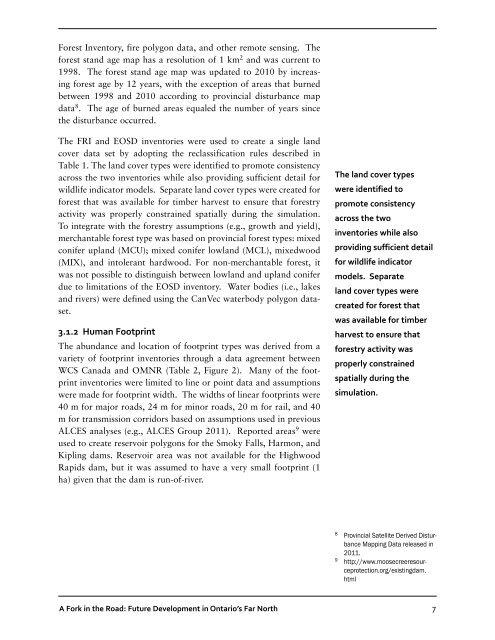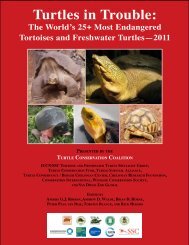You also want an ePaper? Increase the reach of your titles
YUMPU automatically turns print PDFs into web optimized ePapers that Google loves.
Forest Inventory, fire polygon data, and other remote sensing. The<br />
forest stand age map has a resolution of 1 km 2 and was current to<br />
1998. The forest stand age map was updated to 2010 by increasing<br />
forest age by 12 years, with the exception of areas that burned<br />
between 1998 and 2010 according to provincial disturbance map<br />
data 8 . The age of burned areas equaled the number of years since<br />
the disturbance occurred.<br />
The FRI and EOSD inventories were used to create a single land<br />
cover data set by adopting the reclassification rules described in<br />
Table 1. The land cover types were identified to promote consistency<br />
across the two inventories while also providing sufficient detail for<br />
wildlife indicator models. Separate land cover types were created for<br />
forest that was available for timber harvest to ensure that forestry<br />
activity was properly constrained spatially during the simulation.<br />
To integrate with the forestry assumptions (e.g., growth and yield),<br />
merchantable forest type was based on provincial forest types: mixed<br />
conifer upland (MCU); mixed conifer lowland (MCL), mixedwood<br />
(MIX), and intolerant hardwood. For non-merchantable forest, it<br />
was not possible to distinguish between lowland and upland conifer<br />
due to limitations of the EOSD inventory. Water bodies (i.e., lakes<br />
and rivers) were defined using the CanVec waterbody polygon dataset.<br />
3.1.2 Human Footprint<br />
The abundance and location of footprint types was derived from a<br />
variety of footprint inventories through a data agreement between<br />
<strong>WCS</strong> <strong>Canada</strong> and OMNR (Table 2, Figure 2). Many of the footprint<br />
inventories were limited to line or point data and assumptions<br />
were made for footprint width. The widths of linear footprints were<br />
40 m for major roads, 24 m for minor roads, 20 m for rail, and 40<br />
m for transmission corridors based on assumptions used in previous<br />
ALCES analyses (e.g., ALCES Group 2011). Reported areas 9 were<br />
used to create reservoir polygons for the Smoky Falls, Harmon, and<br />
Kipling dams. Reservoir area was not available for the Highwood<br />
Rapids dam, but it was assumed to have a very small footprint (1<br />
ha) given that the dam is run-of-river.<br />
The land cover types<br />
were identified to<br />
promote consistency<br />
across the two<br />
inventories while also<br />
providing sufficient detail<br />
for wildlife indicator<br />
models. Separate<br />
land cover types were<br />
created for forest that<br />
was available for timber<br />
harvest to ensure that<br />
forestry activity was<br />
properly constrained<br />
spatially during the<br />
simulation.<br />
8<br />
Provincial Satellite Derived Disturbance<br />
Mapping Data released in<br />
2011.<br />
9<br />
http://www.moosecreeresourceprotection.org/existingdam.<br />
html<br />
A Fork in the Road: Future Development in Ontario’s Far North<br />
7







![RaLand / SeaScape [PDF] - Wildlife Conservation Society](https://img.yumpu.com/49974326/1/190x245/raland-seascape-pdf-wildlife-conservation-society.jpg?quality=85)









